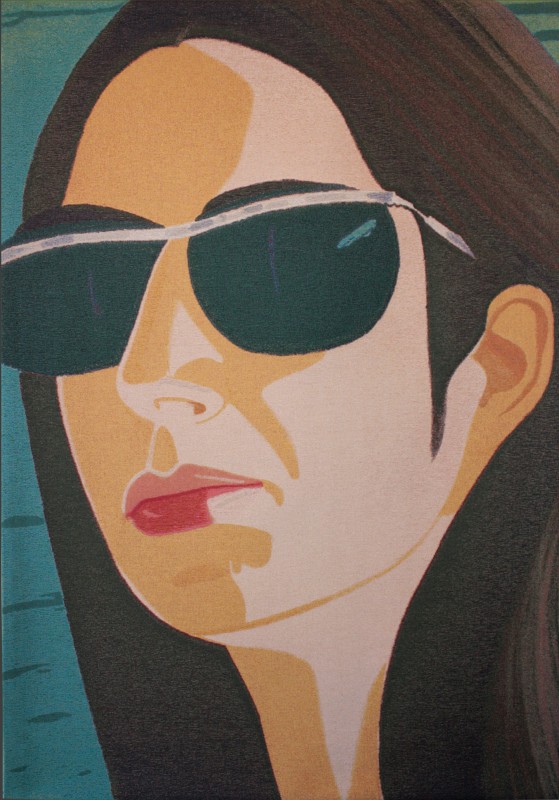
Jacquard tapestry
80 x 55 in.
edition of 10
Born and raised in New York City, Alex Katz is a prominent figure in the generation of painters who dedicated themselves to figurative art even as the reigning style of the day, the gestural abstraction of the New York School, all but declared the death of portraiture. His flat expanses of color, unhurried lines, and reductive compositions stood in stark contrast to Ab Ex splatter and what critic Roger White labels “the abstract expressionist values of existential depth and heroic struggle.” The measured combination of abstraction and representation in Katz’s work has had a profound and lasting influence on multiple generations of artists working today.
To create Ada with Sunglasses, Donald Farnsworth worked with Katz to develop a digital instruction set, called a weave file, translating Katz’s composition into data which could be read by an electronic Jacquard loom in Belgium. This customized Dornier loom uses 17,800 Italian dyed cotton warp threads woven at 75 shots per cm, generating colors via different combinations of eight warp thread colors and the ten weft thread colors selected by Farnsworth. A color palette must be selected for each tapestry edition containing all of the necessary values; for Ada with Sunglasses, a palette of 500 colors was used. Although a conservative color space by digital standards, this is an extraordinary spectrum for the world of weaving, requiring that the color data be broken down for the loom into two sets of 250 colors which must then sync up exactly without containing duplicate information. A digital file is then constructed based on this palette; since the loom reads this file directly, the accuracy of a tapestry depends entirely upon the accuracy of its weave file. “The weave file consists of three correlated documents,” explains Farnsworth, “a spreadsheet describing weave structures, table position, and Lab [color space] values; an image file; and a color lookup table. There is more raw data in the weave file for a single tapestry than if you combined the text of all of Shakespeare’s plays. And just as misspellings or missing lines would stick out in an edition of works by Shakespeare, the data in the weave file has to be completely accurate in terms of color, value, and coordinate.” For more than six months Farnsworth and Katz worked to develop a proof which met with the artist’s approval; Katz, the consummate painter, mixed colors at his New York studio to use as guides in selecting the woven colors.
While this is Katz’s first tapestry edition, it is also a continuation of an ongoing series of portraits of his wife, Ada, begun in the late 1950s and encompassing a variety of styles and media. It is nearly impossible to find a critical treatment of the artist’s work in any medium which does not marvel at its “cool,” a signature mood has been explained variously as a “relaxed blankness” (White), “enforced ambiguity” (Richard Prince), and “genius in disguise” (Tom Breidenbach). The quintessential cool ascribed to Katz is fostered in part by the air of poise and effortless chic radiated by Ada, a figure described by Irving Sandler as being at once “woman, wife, mother, muse, model, sociable hostess, myth, icon, and New York goddess.” Ada with Sunglasses weds the familiar, somatic warmth of a textile with the unflappable cool of Ada, whose eyewear powerfully reinforces the viewer’s sense of her as equal parts icon and enigma. There is a beguiling softness in both the work’s woven surface and the subtle, graduated shifts in color in Ada’s hair, adding a new and unexpected note to the austere harmony that characterizes a Katz composition. – Nick Stone
show prices
Prices and availability are subject to change without notice.The copyright of all art images belongs to the individual artists and Magnolia Editions, Inc.
©2003-2025 Magnolia Editions, Inc. All rights reserved. contact us
